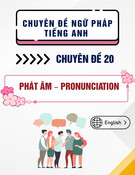
TNU Journal of Science and Technology
229(03): 142 - 150
http://jst.tnu.edu.vn 142 Email: jst@tnu.edu.vn
EFL TEACHERS' STRATEGIES FOR MINIMIZING NINTH GRADERS'
ENGLISH PASSIVE VOICE ERRORS
Ha Thuy Van Hy1*, Duong My Tham2
1University of Social Sciences and Humanities, Ho Chi Minh City
2Ho Chi Minh City University of Economics and Finance
ARTICLE INFO
ABSTRACT
Received:
10/11/2023
This research was conducted to investigate English teachers' strategies for
minimizing ninth graders' errors in using English passive voice. The
participants were four teachers who were teaching at a secondary school in a
Vietnamese rural region. The research analyzed the qualitative data from
four online teacher interviews which included nine questions. The research
results showed that, regarding feedback strategies, most of the teachers
preferred indirect feedback, including techniques such as encouraging self-
correction and circling errors in homework for students to correct
independently. Feedback timing varied, with some teachers addressing errors
at the end of the lesson, while others provided immediate correction. In terms
of language instruction, teacher participants proposed four major strategies:
instruction in mother tongue, focus on forms, focus on meaning, and fun
extra activities. Especially, focus on forms through grammar reinforcement
was emphasized, meaning that the teachers highlighted the importance of
regular and irregular participle verbs, tenses, and sentence analysis. Focus on
meaning was also deemed essential to enable students to understand sentence
meanings effectively, entailing the need for vocabulary improvement.
Revised:
18/01/2024
Published:
18/01/2024
KEYWORDS
English passive voice
Teaching strategy
Error minimization
Corrective feedback
Language instruction
CHIẾN LƯỢC CỦA GIÁO VIÊN TIẾNG ANH TRONG VIỆC GIẢM THIỂU
LỖI SAI CỦA HỌC SINH LỚP 9 TRONG VIỆC SỬ DỤNG CÂU BỊ ĐỘNG
Hà Thụy Vân Hy1*, Dương Mỹ Thẩm2
1Trường Đại học Khoa học Xã hội và Nhân văn, Thành phố Hồ Chí Minh
2Đại học Kinh tế Tài Chính, Thành phố Hồ Chí Minh
THÔNG TIN BÀI BÁO
TÓM TẮT
Ngày nhận bài:
10/11/2023
Nghiên cứu này được thực hiện để tìm hiểu các chiến lược của giáo viên
tiếng Anh lớp 9 nhằm giảm thiểu lỗi của học sinh khi sử dụng câu bị động
trong tiếng Anh. Những người tham gia là bốn giáo viên đang giảng dạy tại
một trường trung học cơ sở ở một vùng nông thôn Việt Nam. Nghiên cứu
đã phân tích dữ liệu định tính từ bốn cuộc phỏng vấn giáo viên trực tuyến
bao gồm chín câu hỏi. Về mặt chiến lược khi nhận xét cho học sinh, kết quả
nghiên cứu cho thấy hầu hết các giáo viên đều thích nhận xét gián tiếp hơn,
tức họ thường khuyến khích học sinh tự sửa lỗi hoặc khoanh tròn lỗi sai để
học sinh tự sửa. Thời gian giáo viên cho nhận xét cũng rất khác nhau, và
trong khi một số giáo viên nhận xét về các lỗi ở cuối bài học, những giáo
viên khác sửa lỗi ngay lập tức trong khi vẫn cố gắng duy trì một không khí
tích cực trong lớp. Về ngôn ngữ giảng dạy, giáo viên tham gia nghiên cứu
đề xuất bốn chiến lược chính: chỉ dẫn bằng ngôn ngữ mẹ đẻ, tập trung vào
cấu trúc, tập trung vào nghĩa và bổ sung các hoạt động ngoài thú vị. Đặc
biệt, việc chú trọng vào cấu trúc thông qua việc củng cố ngữ pháp rất được
giáo viên chú trọng. Điều này có nghĩa là họ nhấn mạnh tầm quan trọng của
việc học các động từ có quy tắc và bất quy tắc, và phân tích câu. Tập trung
vào nghĩa cũng được coi là cần thiết để giúp học sinh hiểu nghĩa câu một
cách hiệu quả, kéo theo nhu cầu học sinh cần cải thiện vốn từ vựng.
Ngày hoàn thiện:
18/01/2024
Ngày đăng:
18/01/2024
TỪ KHÓA
Câu bị động tiếng Anh
Chiến lược dạy
Gỉam thiểu lỗi sai
Nhận xét sửa lỗi
Ngôn ngữ hướng dẫn
DOI: https://doi.org/10.34238/tnu-jst.9176
* Corresponding author. Email: vanhy764@gmail.com

TNU Journal of Science and Technology
229(03): 142 - 150
http://jst.tnu.edu.vn 143 Email: jst@tnu.edu.vn
1. Introduction
EFL and ESL education has experienced significant development over the past few years,
with increasing emphasis on all four language skills. However, the process of learning a language
can never be separated from that of learning its grammar. Among the many structures in English
grammar, English passive voice (EPV) which has been integrated into the teaching syllabus in
most English educational institutions around the world and specifically in the public sector in
Vietnam remained one of the essential components. Unfortunately, the way teachers have
conveyed it in the classroom, which is purely by means of the conversion exercise, poses a
number of problems in students‟ comprehension and practice [1]. As a result, the correct usage of
EPV presents a common challenge for language learners in general [2], much less those at
beginner levels. To address this issue, educators often find themselves exploring innovative
strategies to enhance students' understanding of EPV and minimize passive errors in utterances.
This article, therefore, aims to focus specifically on the strategies employed by teachers to
minimize young learners‟ passive voice errors.
Despite the significance of this grammatical feature in the field of English teaching and
learning, there exists a huge research gap. While a number of studies have examined passive
voice instruction strategies [3]-[6], the participants in those studies are mainly adults in tertiary
education. This means that limited attention has been given to the younger group in secondary
schools or lower [7], and even fewer researchers touched on the area of EPV error corrective
strategies. This research aims to bridge this gap by scrutinizing the strategies EFL teachers use to
tackle the passive voice errors made by ninth-grade students. Through this exploration, the
researchers want to provide profound insight into pedagogical methods that can improve EPV
usage at this important period of language development.
The research question in this study is “What strategies do EFL teachers use to avoid ninth
graders' common errors in English passive voice in a secondary school in Binh Duong, Vietnam?”
To deal with the common errors learners make when studying EPV, proper instruction along
with timely feedback and correction from teachers indeed play an indispensable role in the
teaching process.
1.1. Language instruction
First and foremost, in terms of the effective methods to teach EPV, there are two main types of
form-focused instruction specializing in grammar teaching - focus on form (FoF) and focus on
forms (FoFs). By definition, they are different in terms of the degree to which the instructors direct
students' attention to the grammatical features [8]. The goal of FoFs teaching is to understand
grammatical items rather than to acquire and use language for conversation, so its emphasis is on
the formal aspects of language through isolated linguistic structures in a sequence predetermined by
a syllabus designer or textbook writer because the assumption is that in classroom settings,
language competence is best achieved through a return to discrete-point grammar teaching. In
comparison with FoFs, FoF consists of an occasional shift of focus to linguistic features, which is
triggered by perceived difficulties with comprehension or production [9]. Aghayi and Nourdad [10]
conducted a quasi-experimental study to compare the effect of FoF and FoFs on learning EPV in
different tenses including simple, continuous, perfect and perfect continuous in past, present, and
future. The results revealed the FoF group outperformed FoFs group in learning EPV.
In striking contrast to FoF and FoFs instructions, focus on meaning (FoM) is also applied in
grammar teaching sometimes. FoM is a type of student-centered teaching that shifts the emphasis
of the students' attention away from grammatical or linguistic patterns and toward the meaning of
language. In FoM, which bases its claims on the idea of communicative competence, the main
goal of ESL lessons should be to give students the practice they need to fulfill their
communication requirements in the target language [10].

TNU Journal of Science and Technology
229(03): 142 - 150
http://jst.tnu.edu.vn 144 Email: jst@tnu.edu.vn
Among the three aforementioned types of language instructions, FoF stands out as the most
effective one, which has been confirmed in a variety of studies. For instance, Saeidi, Shatery, and
Zaferanieh [11] carried out a study on the efficacy of FoF, FoFs, and FoM on vocabulary learning
in three types of tasks - dictogloss task, reading and discussion tasks, and word lists. According
to their results, students in the FoF group outperformed those in the FoM and FoFs in terms of
test grades. Interestingly, the FoM group scored considerably better than the FoFs group. Another
study that investigated the benefits of FoF belongs to Gholami and Talebi [12]. They attempted to
examine the function of implicit and explicit FoF strategies in Iranian learners on their linguistic
accuracy. Their results showed that the FoF groups did better than the control group.
Interestingly, additional score analysis also revealed that the implicit FoF group that received
clarification and recast achieved better results compared to the group getting explicit FoF.
1.2. Corrective feedback
Besides appropriate instructional strategies, teachers' prompt feedback and correction are also
critical components of the EPV teaching process. The effectiveness of corrective feedback (CF)
indeed has been proven by plenty of other experimental studies [13]-[16], indicating that CF
assists language acquisition. Therefore, it is obvious that there have been a number of
classifications for different types of feedback. Regarding written CF, Ellis [17] distinguishes
between direct, indirect, and metalinguistic strategies of correction. On the other hand, with
respect to oral CF, two significant contrasts emerging are explicit versus implicit CF and input-
providing versus output-prompting CF. These characteristics can be combined to provide the
taxonomy illustrated in Table 1.
Table 1. A taxonomy of CF strategies
Implicit
Explicit
Input-providing
Recast
Explicit correction
Output-providing
Repetition
Clarification request
Metalinguistic explanation
Elicitation
Paralinguistic signal
To be more specific, with direct feedback, learners are given the proper forms, but in indirect
feedback, learners are given suggestions indicating that there is something wrong in their
utterances, with the hope that learners would find the correct forms on their own [18].
In measuring the effectiveness of different strategies in oral language, Tayebipour [18] concluded
that, as opposed to implicit methods like recasts, explicit correction is more helpful because students
may have opportunities for awareness raising. This was confirmed by Rassaei [19], who explained
that learners who received explicit correction usually outperformed those who received recasts
because the explicit correction group could more easily identify the gap or consider the interlocutors'
corrective utterances as CF, and Lyster et al [20], who claimed that learners who received explicit
correction showed greater progress on several measures than those who received recasts.
Regarding written CF, the debate of whether implicit or explicit written CF is better never
comes to an end. For instance, Chandler [21] reported on the advantage of direct CF over indirect
CF, but the research of Ferris and Helt [22], and Laland [23] showed the superiority of indirect
CF. Especially, in the context of Vietnam, Pham and Iwashita [24] demonstrated a significant
enhancement in students' accuracy by employing indirect feedback. This result was attributed to
the fact that this approach allowed students to rectify errors in grammar, morphology, and syntax,
thereby contributing to their overall improvement.
Regarding when to make use of those two types of feedback, it seems that most researchers
have a quite similar view, which is that teachers should avoid immediate correction during
„fluency' work. Hedge [25], for example, noted that teachers' notes accompanying course
materials commonly encouraged teachers to delay correction until the completion of fluency
tasks. Scrivener [26] also proposed that teachers keep a record of the errors during a fluency or

TNU Journal of Science and Technology
229(03): 142 - 150
http://jst.tnu.edu.vn 145 Email: jst@tnu.edu.vn
communication task and rectify them after the activity is completed. She advised teachers to
postpone providing feedback until learners have completed a communicative task since providing
feedback while the task is being performed will have a negative effect on fluency.
2. Research method
To answer the research questions, this study employed qualitative research with the data drawn
from four teacher interviews. Regarding the sampling method, the researchers employed
convenience sampling for the study. In particular, the sample of this study consisted of four English
teachers teaching 9th graders in the school year 2019-2020 at a secondary school in Binh Duong
province, Vietnam, and all four of them were willing to participate in the study, thus becoming the
teacher participants. All of the teacher participants are females, with qualified Bachelor‟s degrees.
Besides all of them are more than 40 years old with about 20 years of teaching experience, which
proves their pedagogical expertise. In this research, each teacher would be assigned a number to
represent their name, including teachers (1), (2), (3), and (4). A semi-structured one-on-one
interview with the teachers was arranged. The interview form which is adapted from Bui [27] and
Creswell [28] included nine questions. To be more specific, the first two questions aim to gain the
teachers‟ academic background, while the remaining ones are to find out their opinion on the
research problem and what suggestions they can provide the researcher with.
3. Findings and discussion
3.1. Strategies involving language instruction that teachers used
In addition to the aforementioned correction strategies, several solutions involving language
instruction were adopted to prevent errors in EPV. They can be presented in four main themes:
instruction in L1, focus on forms, focus on meaning, and fun extra activities. Interestingly, all
teachers in the interviews stated that they did use Vietnamese in EPV teaching and translation to
help students absorb the knowledge better in their mother tongue. The teachers also stressed that
they needed to make lessons short, and simple, but long-lasting in students‟ minds by not
overusing the grammatical terms and the definitions. Hence, they could feel motivated to learn
such a challenging grammar point.
As a teacher, I think we can try to modify the lesson plans and improve our own classroom
management skills so they‟re motivated to learn. Secondary students are easily discouraged, so
they have to stay motivated to learn not only in class, but also after class. Therefore, I give them
practice exercises and organize activities so that their mind is constantly in the lesson. (Teacher 4)
As all teachers perceived grammatical incompetence as a major underlying cause for errors in
EPV, focusing on forms and grammar reinforcement are indispensable parts of lesson plans and
the teachers felt the need to check students‟ grammatical knowledge regularly. As regards verb
forms, they would constantly get the students to learn regular and irregular participle verbs
carefully in many ways, one of which is organizing tests focusing on those verbs. To deal with
errors related to tenses, they also reminded students of the way to recognize the tenses of
sentences. Fortunately, Teacher 3 suggested a helpful way to practice these two grammatical
features, which is to give one verb, and then ask students to write different tenses of that verb and
change these sentences into passive voice. Regarding those who had problems with identifying
different elements in a sentence, Teacher 2 would ask them which one is “the place”, “the time”,
and etc. in the sentence in facilitating them in passive formation.
I think that they make these errors because they are confused about the meanings of the EPV
structures, and in some cases, they forget certain grammar rules involved with these EPV
structures… I think these errors are common with weak and average students, because of their
lack of knowledge in sentence formation and transformation. It‟s like they are confused about the
positions of elements in the sentences. They have trouble figuring out where is the „subject‟, the
„verb‟ and „to be‟ (Teacher 4).

TNU Journal of Science and Technology
229(03): 142 - 150
http://jst.tnu.edu.vn 146 Email: jst@tnu.edu.vn
Meaning is also another linguistic aspect that was prioritized in language instruction. Half of
the interviewed teachers felt the need to pay careful attention to this field by encouraging their
students to improve the lexical resource as they agreed that vocabulary is the chief culprit behind
students‟ errors in EPV.
Some possible causes for these problems are, I think, students don‟t master vocabulary, so they
don‟t understand the meaning of the sentence. They can‟t translate or understand the sentence in
their own language to recognize which one is “subject, verb, object, place, time”. (Teacher 2)
Teacher 4 elaborated on the matter by saying that due to limited vocabulary, they had
difficulty figuring out the meaning of the sentences. Not understanding the meaning of the active
sentence, they could not recognize the subject, verb, object, adverb of place, and adverb time, and
thus were not able to change it into the passive voice. To tackle the gaps in lexical resources,
Teacher 2 advised students to learn more vocabulary to understand the meaning of the sentence.
She highly recommended a reference book “Ôn tập Tuyển sinh lớp 10 của tỉnh Bình Dương”
which contains useful exercises about vocabulary and phrasal verbs according to a myriad of
topics. All teachers agreed that to completely tackle the root causes for errors in EPV, students
should have more practice by revising their own lessons carefully and doing all the exercises in
the course book again after school. All of them wanted to give learners more assignments with
difficulty levels depending on their English competency. Two grammar books recommended for
this purpose are the series “Mai Lan Huong” and “Cambridge Grammar in Use”.
I think the first thing is, practice makes perfect. I often tell my students “Practice makes
perfect”, so I ask them to do a lot of exercises in a grammar book. For example, the book is “Mai
Lan Hương”. This book contains a lot of similar sentences like the structures I teach in school,
and I ask them to practice this every day, or use these structures in combination. Besides that,
they have to learn by heart the verb past participles. (Teacher 3)
Finally, to strengthen learners‟ motivation during the English period so they would continue
to learn by themselves even when they step out of the class, some added extra interesting
activities such as learning from useful websites on the Internet (Teacher 2) and playing some
games as free practice activities (Teacher 4). Teacher 4, however, warned that the teacher in
charge must set a clear target for the lesson as there should not be too many free practice
activities and too few controlled practice activities.
I think there are a lot of websites to learn vocabulary on this topic. For example,
tienganh123.com, The IELTS Workshop. I think there are lots of websites. I just asked them, for
example, to go to Google. You can go to Google search and you can type in a certain topic and
you can choose which one is related to this topic and you discover them. I ask students to do that.
(Teacher 2)
Overall, teacher participants suggested four major strategies for language instruction:
instruction in mother tongue, FoFs, FoM, and fun extra activities. They stressed the use of the
Vietnamese language and translation as aids to students' comprehension in passive teaching.
Focus on forms through grammar reinforcement was emphasized. In other words, teachers tended
to focus on teaching and learning regular and irregular participle verbs, tenses, and sentence
analysis. They also perceive FoM as necessary to help enable students to understand sentence
meanings effectively, thus students need to improve their vocabulary.
3.2. Strategies involving corrective feedback that teachers used
To help students correct the errors mentioned above, the teacher participants suggested a
number of strategies they did actually use in their own teaching practice. Regarding the
explicitness of CF, the majority of the interviewed teachers opted for indirect CF when helping
their students correct the errors in EPV. To be more specific, instead of writing the correct
answers for students immediately, Teacher 1 would leave out the errors and ask students to say
what they remember about that structure in EPV first. Regarding the errors in homework, she












![Bài tập thì hiện tại hoàn thành [kèm đáp án chi tiết]](https://cdn.tailieu.vn/images/document/thumbnail/2025/20251106/thuthao27062004/135x160/41601762420911.jpg)






![Tài liệu ôn tập Ngữ pháp tiếng Anh [chuẩn/mới nhất/tổng hợp]](https://cdn.tailieu.vn/images/document/thumbnail/2025/20250821/vuongdinhlinh1412@gmail.com/135x160/933_tai-lieu-on-tap-ngu-phap-tieng-anh.jpg)




